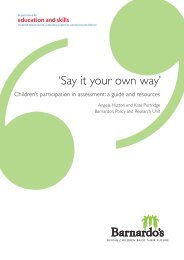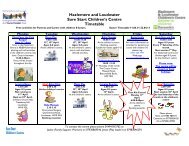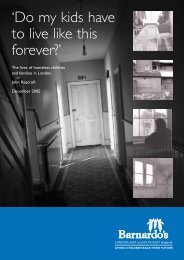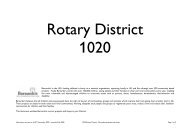Splintered Lives - Barnardo's
Splintered Lives - Barnardo's
Splintered Lives - Barnardo's
You also want an ePaper? Increase the reach of your titles
YUMPU automatically turns print PDFs into web optimized ePapers that Google loves.
PAGE 20<br />
chapter<br />
5 involved with several victims, all of whom are aware of each other's participation',<br />
(p111); but is close to that developed by NJ Wild (1989): 'repeated abuse of multiple<br />
victims from more than one family... comprising an adult perpetrator (or perpetrators)<br />
and several children who are simultaneously involved in sexual activity and aware of<br />
each other's participation' (p553). Unlike Wild, however, we view what is necessary for a<br />
ring is that either the children or the perpetrators are from different families. Children<br />
do not have to witness, or even be aware of one another's abuse. The more individuals<br />
are involved, and the more aware they are of each other's existence the more critical<br />
control becomes, since each additional person (including customers) increases the<br />
possibility of being exposed/discovered.<br />
The Council of Europe's most recent definition of sexual exploitation is: "the sexual use<br />
for economic purposes of a child or a young person, which violates, directly or<br />
indirectly human dignity and sexual freedom and endangers his/her psycho-sexual<br />
development" (Council of Europe, 1991, p15). The document then proceeds to specify<br />
that this includes pornography, prostitution and trafficking, that a child is anyone under<br />
the age of 16, and a young person someone aged between 16 and 21. Trafficking is<br />
further defined as: "Any act or activity aimed at bringing a child or a young person into<br />
prostitution or pornography or maintaining him/her there, possibly by transporting<br />
him/her at national or international level, even with his/her consent or by means of<br />
deception, threats, force or other influence" (p26).<br />
If the issues raised in this section are taken seriously there are several difficulties with<br />
this definition:<br />
�� the limitation to 'economic purposes';<br />
�� the age-based definitions of child and young person.<br />
Further debate and exploration of definitions is urgently needed, since they are the<br />
conceptual framework within which legislation, policy, data collection and research are<br />
located. It is our view that attention needs to be given to this matter before other steps<br />
are taken. What is needed are analytic definitions linked to both the UN declaration and<br />
what we currently know about sexual exploitation, and less inclusive working<br />
definitions which recognise that legal frameworks, and hence available national data do<br />
not conform to the broader definition. Without this the disjunction between<br />
international law and national practices will remain a barrier to practical progress.<br />
Geert Cappelare (1995) provided a useful starting point for these debates, which we<br />
have adapted here, to reflect the issues raised in this section. Figure One locates sexual<br />
exploitation within the widespread violation of children's rights, and exploitation and<br />
victimisation more broadly. Whilst the original model had at it's apex commercial<br />
sexual abuse of children, we include a shaded area in the victimisation and exploitation<br />
section to encompass other contexts in which children are sexually exploited.
















